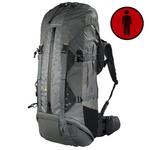Decathlon Quechua Forclaz 70 + 10 Symbium 4

Designed for multi-day hikes and treks in complete autonomy.
This rucksack is extremely comfortable, even when carrying heavy loads, and has many practical features!
With the Symbium 4 system, this bag takes you to the top! The system is the fruit of 3 years of research and tests, guarantees less fatigue and pressure on the shoulders, even when heavily loaded.
Capacity: 68litres + 12 litre / 2.8 kg extension.
Easy storage: Pockets: 1 inner, 3 outer, 1 belt. Front opening. Expandable. Pole holder.
Anatomic design: Adapted to men's morphology. Adjustable back.
Efficiency: Freedom of movement. Chest strap. 2 position "ALL" tensioners.
Moisture transfer: Ventilated back.
Restricted use not suitable for hikers under 1.65m.
Warranty : 5 years
Color : grey
approved by: In a blind test featuring 2 other high quality rucksacks (one Quechua and one from an International brand of Mountain rucksacks) on a mountain hike, the Symbium 4 was given the best mark for perceived comfort by 81% of testers (8 men + 8 women).
Care instructions: in order to maintain the fabrics’ specific properties (especially waterproofness), we advise you not to machine wash, tumble dry, dry clean, bleach or iron your rucksack. You can clean it by hand using lukewarm soapy water and a brush (if required). After a few years of use, you can use “waterproofing” spray to regenerate the water-repellent qualities of the fabrics.
Stocking advice: store your rucksack in a dry place.
This product has been conceived with the following concepts
The “Air Cooling” seal of approval:
Rucksacks which feature the “Air Cooling” seal of approval have been laboratory-tested in order to assess the performance of their ventilation system: a heated dummy which can produce artificial sweat provides a scientific and objective measurement of the rucksack’s ability to limit perspiration. Only the rucksacks whose capacities are significantly superior to those of a “basic” model in the range (which do not feature any particular ventilation system) are awarded this seal of approval.
How is the capacity of a rucksack measured?
The capacity of each of our rucksacks is measured as per a standardised method: we fill the main compartment as well as every pocket with small balls. All the balls used are then emptied into a graduated container to give the rucksack’s capacity in litres.
How to pack a rucksack:
Put sleeping equipment at the bottom. Position heavy items (tent, stove, food, etc.) close to the back. Clothes can be placed all around these. You can put a mattress under the lid and a tent can be fixed underneath the rucksack if there is no room left inside. Make sure your windcheater and fleece jacket are easily accessible. Use the pockets to store the small accessories (sun lotion, map, sunglasses, etc.) you will need during the hike. Usually, there is a compartment along the back which is
How to fit a rucksack:
LOOSEN all the straps (shoulder strap, hip belt, tensioners). PUT THE RUCKSACK ON YOUR BACK. For rucksacks with a capacity of 50L or more, PLACE THE HIP BELT CORRECTLY (over the hip bones) and FASTEN IT. For rucksacks with a smaller capacity, the hip belt should be placed around the waist. FASTEN THE SHOULDER STRAPS. Finally, ADJUST THE TENSIONERS to your individual requirements.
How to adjust the rucksack’s back length:
Position the adjustable back system as indicated as standard then fit the rucksack (see the “How to fit a rucksack” section). With the hip belt over your waist, the shoulder straps should cover the front area of your shoulders, and the tensioners (which are also sometimes adjustable in height) should be at a 45° angle (and not in a vertical or horizontal position). If you feel the back is too short or too long, restart the process until you feel comfortable.
The Symbium system:
The Symbium pivoting hip belt and the elasticated shoulder straps allow the shoulders and waist to move as freely as possible. They reduce stress points and so provide extra comfort during long hikes.
Rucksack technical tests:
Before the components of a rucksack are given our stamp of approval, they are submitted to a series of laboratory tests. For example, a fabric will be tested for its resistance to abrasion, tearing, UV rays, repeated washing, penetration by water, etc… A final test on the finished product is carried out in order to reproduce the kind of treatment it is likely to be subjected to over the years. The heavily-weighted rucksack is put on a dummy which imitates the movements of a fast-walking hiker.
This rucksack is extremely comfortable, even when carrying heavy loads, and has many practical features!
With the Symbium 4 system, this bag takes you to the top! The system is the fruit of 3 years of research and tests, guarantees less fatigue and pressure on the shoulders, even when heavily loaded.
Capacity: 68litres + 12 litre / 2.8 kg extension.
Easy storage: Pockets: 1 inner, 3 outer, 1 belt. Front opening. Expandable. Pole holder.
Anatomic design: Adapted to men's morphology. Adjustable back.
Efficiency: Freedom of movement. Chest strap. 2 position "ALL" tensioners.
Moisture transfer: Ventilated back.
Restricted use not suitable for hikers under 1.65m.
Warranty : 5 years
Color : grey
approved by: In a blind test featuring 2 other high quality rucksacks (one Quechua and one from an International brand of Mountain rucksacks) on a mountain hike, the Symbium 4 was given the best mark for perceived comfort by 81% of testers (8 men + 8 women).
Care instructions: in order to maintain the fabrics’ specific properties (especially waterproofness), we advise you not to machine wash, tumble dry, dry clean, bleach or iron your rucksack. You can clean it by hand using lukewarm soapy water and a brush (if required). After a few years of use, you can use “waterproofing” spray to regenerate the water-repellent qualities of the fabrics.
Stocking advice: store your rucksack in a dry place.
This product has been conceived with the following concepts
The “Air Cooling” seal of approval:
Rucksacks which feature the “Air Cooling” seal of approval have been laboratory-tested in order to assess the performance of their ventilation system: a heated dummy which can produce artificial sweat provides a scientific and objective measurement of the rucksack’s ability to limit perspiration. Only the rucksacks whose capacities are significantly superior to those of a “basic” model in the range (which do not feature any particular ventilation system) are awarded this seal of approval.
How is the capacity of a rucksack measured?
The capacity of each of our rucksacks is measured as per a standardised method: we fill the main compartment as well as every pocket with small balls. All the balls used are then emptied into a graduated container to give the rucksack’s capacity in litres.
How to pack a rucksack:
Put sleeping equipment at the bottom. Position heavy items (tent, stove, food, etc.) close to the back. Clothes can be placed all around these. You can put a mattress under the lid and a tent can be fixed underneath the rucksack if there is no room left inside. Make sure your windcheater and fleece jacket are easily accessible. Use the pockets to store the small accessories (sun lotion, map, sunglasses, etc.) you will need during the hike. Usually, there is a compartment along the back which is
How to fit a rucksack:
LOOSEN all the straps (shoulder strap, hip belt, tensioners). PUT THE RUCKSACK ON YOUR BACK. For rucksacks with a capacity of 50L or more, PLACE THE HIP BELT CORRECTLY (over the hip bones) and FASTEN IT. For rucksacks with a smaller capacity, the hip belt should be placed around the waist. FASTEN THE SHOULDER STRAPS. Finally, ADJUST THE TENSIONERS to your individual requirements.
How to adjust the rucksack’s back length:
Position the adjustable back system as indicated as standard then fit the rucksack (see the “How to fit a rucksack” section). With the hip belt over your waist, the shoulder straps should cover the front area of your shoulders, and the tensioners (which are also sometimes adjustable in height) should be at a 45° angle (and not in a vertical or horizontal position). If you feel the back is too short or too long, restart the process until you feel comfortable.
The Symbium system:
The Symbium pivoting hip belt and the elasticated shoulder straps allow the shoulders and waist to move as freely as possible. They reduce stress points and so provide extra comfort during long hikes.
Rucksack technical tests:
Before the components of a rucksack are given our stamp of approval, they are submitted to a series of laboratory tests. For example, a fabric will be tested for its resistance to abrasion, tearing, UV rays, repeated washing, penetration by water, etc… A final test on the finished product is carried out in order to reproduce the kind of treatment it is likely to be subjected to over the years. The heavily-weighted rucksack is put on a dummy which imitates the movements of a fast-walking hiker.
Tillverkare: Decathlon
Tillverkarens produktsida
Visar recensioner från | Sortera efter
Produkten har inte recenserats änSkriv en egen recension






